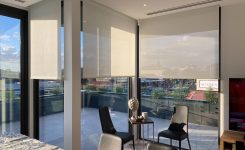Blinds
How do blockout roller blinds work?
Blockout roller blinds are a highly effective window treatment designed to provide complete light control by blocking out sunlight and creating a darkened environment. These blinds are engineered with specialised materials and construction techniques that work together to prevent sunlight from entering a room. Understanding how blockout roller blinds achieve this impressive light-blocking capability involves delving into their design, materials, and functionality. At the core of the blockout roller blind’s light-blocking ability is its fabric. The fabric used in these blinds is specifically designed to have a high opacity, meaning it doesn’t allow light to pass through easily. This is achieved by using multiple layers of tightly woven or coated materials. These layers are strategically combined to create a dense barrier that prevents sunlight from penetrating the fabric. Often, these fabrics are composed of synthetic materials like polyester with added coatings or backing that enhance their light-blocking properties. The fabric’s opacity is only one part of the equation. The design of blockout roller blinds also includes a few essential features that contribute to their ability to block sunlight effectively: Precision Fit: Blockout roller blinds are designed to fit snugly within the window frame or casing. This minimises gaps between the blind and the window, reducing the chances of sunlight seeping through the edges. Side Tracks and Seals: Some advanced blockout roller blinds come with side tracks or seals that run along the edges of the blinds. These tracks ensure a tight fit and prevent light from entering around the sides of the blinds. Top Cassette or Valance: Many blockout roller blinds come with a top cassette or valance that covers the top portion of the blinds when they’re fully rolled up. This adds an extra layer of light-blocking protection at the top of the window. Bottom Bar: The bottom of the blockout roller blind is typically equipped with a heavy-duty bottom bar. This bar not only helps the blind hang straight but also provides additional weight to keep the fabric taut and prevent any light from filtering through the bottom. Overlap and Overhang: Blockout roller blinds are often designed to overlap the window frame slightly when fully lowered. This overlap, along with any additional fabric overhang on the sides, helps to further block light from entering the room. When properly installed and operated, blockout roller blinds can create a nearly pitch-black environment even during the brightest hours of the day. This makes them an excellent choice for spaces where light control is paramount, such as bedrooms, home theaters, or shift workers’ sleeping areas. In addition to their light-blocking capabilities, blockout roller blinds offer other benefits as well. They provide privacy by preventing outsiders from peering into your living space. They also contribute to energy efficiency by reducing heat gain during hot days and heat loss during colder months. The dense fabric and snug fit of these blinds create an additional thermal barrier at the window. In conclusion, blockout roller blinds block sunlight through a combination of their specially designed opaque fabric, precision fit, side tracks, top cassette, bottom bar, and other features that work in harmony to create an effective barrier against incoming light. Their ability to transform any room into a dark, private, and comfortable space makes them an ideal choice for individuals seeking complete light control and a range of other benefits in their living or working environments.

